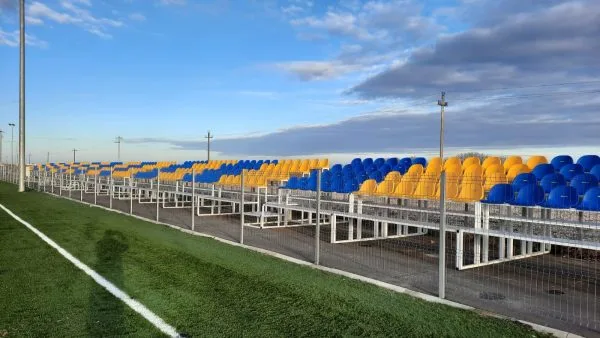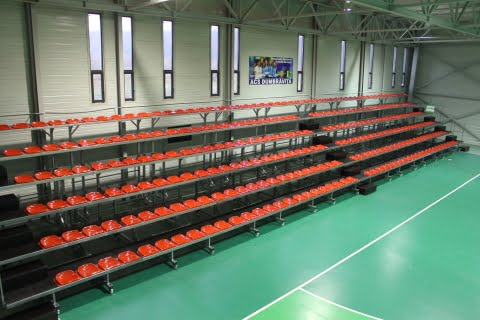The history and evolution of grandstands – comfort, flexibility and modern trends
- Artimex UK
- 7 days ago
- 4 min read
Grandstands (also known as stands or bleacher seating) are elevated structures that provide spectators with an unobstructed view during sporting competitions or cultural events. They are made up of stepped rows, usually sheltered by a roof, and can include additional areas such as VIP boxes, press cabins or restrooms. This layout distinguishes them from simple bleachers, which are often uncovered and offer only bench seating without backrests.
Origins and historical development
Antiquity
The idea of the stand is not new. As early as antiquity, the Romans built tiered seating for amphitheatres so that thousands of spectators could see games and gladiatorial combat. These structures were designed to optimise visibility and formed the basis for the architecture of modern stands.
Modern evolution
In the 19th and 20th centuries, stands became permanent structures in sports arenas, initially built of wood and then of reinforced concrete. Today materials and technologies have evolved: fixed stands are made of galvanised steel, aluminium or reinforced concrete to withstand heavy loads and the elements. Manufacturers also develop modular versions that are easy to assemble and dismantle, allowing the capacity to be adapted quickly to the event.

Types of stands
Portable stands – Prefabricated structures that are easy to move, ideal for temporary events such as festivals or occasional matches. Modular elements allow different dimensions to be configured.
Permanent stadium stands – Designed for long‑lasting sports facilities with high capacity and robust infrastructure. These can be equipped with a roof, VIP boxes, press areas and food courts.
Small covered stands – Compact versions that protect spectators from rain or sun, used at training grounds or local competitions.
Bleachers – Simple stepped benches, often uncovered. They provide a cost‑effective solution for smaller events and can be temporary or permanent. Comfort is reduced compared with stands because the seats have no backrests or armrests.

Comparative characteristics
Criterion | Grandstand | Bleachers |
Structure | Built from durable materials (steel, concrete) and usually covered | Simple benches made of metal or wood, often without a roof |
Comfort | Individual seats with backrests, possibly armrests; may include VIP boxes, bars and press cabins | Long benches without backrests; minimal comfort |
Use | Large events with numerous spectators; requires roof and additional facilities | Smaller or casual events; economical and quick solution |
Flexibility | There are both fixed and modular versions; retractable systems allow the configuration to be changed | Modular and mobile versions available; they are quick to assemble/dismantle |
Retractable and modular systems
Retractable seats: retractable designs allow space to be transformed quickly for different events – from football matches to concerts or ice shows. This maximises the use of space and adapts the size of the stand according to the audience.

VIP areas and premium experiences
Current VIP boxes include reclining chairs, upholstered cushions, catering services and terraces with panoramic views. Demand for such areas has increased, with investments in premium seating representing a significant proportion of stadium seating budgets.
Accessibility and inclusion
Legislation on access for people with disabilities obliges stadiums to include adapted seats; modern designers go further and provide accessible spaces distributed evenly, with seats for companions and audiovisual facilities for people with sensory needs. This ensures the full participation of all spectators.
Sustainability
The use of recycled materials and eco‑friendly design has increased significantly. Almost half of stadiums have switched to seats made from recycled materials. Some stands are equipped with integrated solar panels or solar‑powered USB sockets, and container stands reuse maritime materials. These measures reduce the carbon footprint and align with current environmental concerns.
Considerations when choosing a stand
Event type and duration – For occasional events, mobile stands or bleachers are suitable. Recurring or official events require permanent structures and increased comfort.
Budget – Bleachers are cheaper but offer lower comfort. Modular stands allow the investment to be extended gradually, while VIP boxes involve higher costs.
Available space – The stand must be sized according to the field and spectator flow; retractable systems optimise space.
Regulations and safety – It is essential to comply with local codes regarding structural strength, emergency exits, accessibility and fire protection.

Artimex Sport – expertise in building stands
A major name in the production of spectator stands and sporting equipment is Artimex Sport. The company was founded in 1994 and has more than 20 years of experience in designing and building grandstands. Over those decades it has become a leader in the sports equipment market: the factory produces more than 250 types of products, and ongoing investment in modern technologies ensures quality and fast delivery.
Durable materials and resistant finishes
Artimex stands are built from durable materials: the structure uses robust rectangular steel tubing, and finishes are applied through electrostatic powder coating for long‑lasting protection against corrosion. Seats and floors are made of treated wood or weather‑resistant plywood (Tego), giving the stands stability and comfort. The company has modern facilities for working wood and metal, including a high‑performance paint oven.

Comfort and safety for spectators
The stands are designed so that spectators feel safe and comfortable. The modular configuration divides the stand into independent segments, each equipped with access stairs and railings. Standard models, such as the 45‑seat grandstand, include individual seats with backrests and a weather‑resistant floor, providing enhanced comfort even during long events. In addition, each stand comes with a warranty and meets safety standards, with options to add armrests and other premium finishes.
Tailored to each project
A major advantage of Artimex products is adaptability to each individual project. The modules can be configured to achieve the desired capacity and can be complemented with different types of seats or floors (for example, ribbed wood or aluminium). Customers can choose customised sizes and colours, so that the stands fit perfectly into any project. Flexibility and attention to detail make Artimex stands suitable for schools, sports clubs or large‑scale events.
Thanks to the experience gained and the use of durable materials, the stands produced by Artimex Sport are a reliable and comfortable solution for any arena. The company can compete on the international sports equipment market, offering durable structures, powder‑coated finishes, a focus on spectator safety and the ability to adapt to the needs of every project.
Choosing the right stand depends on the nature of the event, budget and desired level of comfort. Regardless of the option, the goal remains the same as in antiquity: to ensure optimal visibility and a memorable experience for every spectator.





Comments